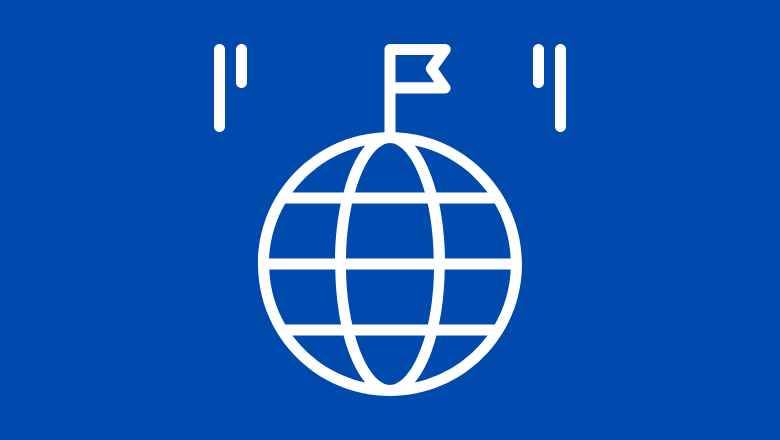Nearshore software outsourcing is when a company outsources its software development work to a neighboring country. For U.S. companies, this often means outsourcing to software teams in Latin America or North America.
Popular nearshore destinations in Latin America include Colombia, Mexico, Brazil, and Argentina. These countries have working hours compatible with all U.S. time zones.
While cost reduction is a factor in outsourcing decisions, businesses often choose nearshore outsourcing for the high level of programming skills and the value it adds to software products. Nearshore providers also typically possess the language skills and cultural compatibility that facilitate smooth collaboration.
What are the types of software outsourcing?
There are three types of software outsourcing: Onshore, Offshore, and Nearshore.
Onshore
Onshore development involves hiring software developers within the same country or region as your company. This is typically the most expensive option, especially in the U.S.
The demand for digital transformation has created a significant talent shortage, particularly in the U.S. market. Gartner reports increases in job openings, turnover, time to fill positions, and salary expectations.
Projects best suited for onshore outsourcing include:
- Those needing frequent in-person collaboration.
- Those with data privacy restrictions on developer locations.
- Projects involving physical elements that require in-person development, like IoT sensors.
Offshore
Offshore software outsourcing means hiring vendors in distant countries, often in Eastern Europe or Asia, such as China or India.
Offshoring is usually the most cost-effective option. However, it comes with tradeoffs and hidden costs. While language barriers are less of an issue now, other challenges remain.
The biggest challenges of offshore development are time zone differences, high turnover, and cultural differences. These factors can hinder communication and slow down the team.
One way to mitigate these issues is to have your offshore team work during the night to overlap with your daytime hours. However, developers and project managers in countries like India now have many job choices due to local companies and large corporations setting up operations there.
Projects best suited for offshore development include:
- Non-automated processes with repetitive tasks.
- IT support projects.
- Less strategic, ambiguous projects.
- Projects that don’t need high collaboration and Agile processes.
- Projects less affected by high turnover.
Nearshore
Nearshore outsourcing involves hiring distributed teams in nearby countries within the same continent or time zone.
For U.S. businesses, this means outsourcing to software development companies in Latin America. Western European countries often outsource to nearby Eastern European countries like Poland or Ukraine.
Nearshoring avoids the major downsides of offshoring. Time zones and cultural similarities make collaboration easy, and the close proximity allows for affordable face-to-face meetings.
The rise of remote work following the Covid pandemic has enabled companies to integrate in-house teams with distributed workers from larger talent pools in Latin America.
Projects best suited for nearshore development include:
- B2B, B2C, and SaaS solutions.
- Projects needing real-time, but not necessarily face-to-face, collaboration.
- Projects leveraging an Agile approach.
- Strategic and ambiguous projects requiring real-time discovery and collaboration.
- Development of new software solutions.
- Modernization of complex legacy software solutions.
How Nearshore Software Outsourcing Works

Nearshore software development lets you expand your team by tapping into resources in nearby countries. You can share the day’s work with your team effortlessly. Nearshore development companies act as a bridge, providing access to talent outside your immediate area. These partners manage and oversee teams throughout Latin America.
They ensure smooth communication, efficient workflows, and cultural compatibility. Many U.S.-based nearshore companies also offer Errors and Omissions (E&O) Insurance. This insurance provides risk management systems uncommon in Latin America. It gives you the protection you need and peace of mind to focus on your project.
Curious about the development process? When outsourcing, you have three standard models to choose from. Each has its benefits. The availability of these models depends on the partner you select.
Why Outsource to a Nearshore Development Company?
Outsourcing software development to a nearshore provider offers several advantages over internal development. Some key benefits include:
Addressing Staff Shortages
Nearshore developers are skilled in project-based work. They can quickly bridge staffing gaps. Their experience with various companies ensures they meet quality standards and fit seamlessly into your team.
Access to Skills
Nearshore outsourcing companies provide access to a wide talent pool. Businesses aren’t limited by their immediate team’s skills. They can tap into the best expertise available in the region without spending money on recruiting the right candidates.
Cultural and Language Similarities
Sharing a language and similar working cultures helps achieve project objectives. Clear communication is vital in software development, and nearshore outsourcing eliminates language barriers.
Improving Company Efficiency
Nearshore providers allow companies to focus on daily business activities. Internal development often leads to workload overload, preventing new project take-ons. Outsourcing frees up time and resources, streamlining processes. According to Technavio’s research, the IT outsourcing industry is expected to grow by $409 billion by 2022, driven by the need to optimize business processes.
Geographical Proximity
Although face-to-face collaboration isn’t necessary, being close to your development provider has its advantages. Low travel costs and timezone compatibility facilitate timely communications. If you need to meet in person, nearshore outsourcing makes this feasible.
How to Outsource to a Nearshore Software Team

Choosing the best nearshore outsourcing team involves careful planning and execution. Here’s a step-by-step guide to help you navigate the process effectively:
Assess Your Organization’s Skills
Start by evaluating your internal team’s skills. Conduct a comprehensive staff survey. This will give you a clear picture of your team’s strengths and weaknesses. For example, you might discover that your team excels in front-end development but lacks expertise in back-end systems.
Next, create a detailed project specification. Define the skills and expertise required for your project. This will help you shortlist nearshore candidates who meet these requirements.
Example: Suppose your project involves developing a complex data analytics platform. You’ll need experts in big data, machine learning, and cloud computing. Shortlist nearshore companies with proven experience in these areas. Ask each company for a breakdown of how they’d approach your project. Look for detailed plans that show a deep understanding of your needs.
Verify the Expertise of Your Shortlist
Before committing to a nearshore company, ensure they can substantiate their expertise. Start by visiting their website. Look for case studies and success stories. These should highlight similar projects they’ve completed successfully.
Contact previous clients for testimonials. Ask about their experiences, focusing on the quality of work, communication, and adherence to deadlines.
Example: If you’re considering a company that claims expertise in mobile app development, ask for references from past clients who have had similar projects. Check third-party reviews on platforms like Clutch and Upwork. Positive feedback from reputable sources is a good indicator of reliability.
Implement Project Management Processes
Effective project management is crucial for the success of your nearshore project. Utilize project management tools like Basecamp, Jira, and Trello. These tools help in organizing tasks, tracking progress, and ensuring clear communication.
Assign dedicated project managers and team leaders. They will be responsible for overseeing the project and ensuring milestones are met. Regular check-ins and updates are essential.
Example: If your project involves developing a new e-commerce platform, break down the project into manageable phases. Use Jira to assign tasks and track progress. Regularly update the project board and hold weekly meetings to discuss progress and address any issues. This structured approach ensures everyone is on the same page and the project stays on track.
Tips
- Pilot Projects: Start with a small pilot project. This helps assess the nearshore team’s capabilities without committing to a large-scale project. If the pilot goes well, you can scale up.
- Cultural Compatibility: Ensure cultural compatibility. Teams with similar working cultures and time zones improve collaboration and productivity.
- Clear Communication Channels: Establish clear communication channels. Use tools like Slack or Microsoft Teams for real-time communication. Regular video calls help maintain a personal connection and clarity.
- Risk Management: Discuss risk management strategies. Ensure the nearshore company has contingency plans for potential issues like delays or technical problems.
Example: Suppose you’re developing a healthcare application. Data security is paramount. Ensure the nearshore team follows stringent security protocols and complies with regulations like HIPAA. Regular security audits and updates should be part of the project plan.
This approach not only maximizes the benefits of nearshore outsourcing but also minimizes risks and challenges.
How to Choose a Nearshore Software Outsourcing Region

Selecting the right region for nearshore software outsourcing is a critical decision that can impact the success of your project. Here are some key factors to consider:
Assessing the Country
Digital Skills Education: Look for countries with robust educational systems that emphasize digital skills. Top universities and specialized training programs produce a talent pool with up-to-date knowledge in software development, AI, and other tech areas.
Example: Brazil and Mexico have numerous technical universities and coding bootcamps that churn out skilled developers annually. This makes them attractive destinations for nearshore outsourcing.
Technology Infrastructure: A strong technology infrastructure is essential. This includes reliable internet connectivity, modern workspaces, and access to the latest tools and technologies.
Example: Colombia has invested heavily in its technology infrastructure over the past decade. Cities like Bogotá and Medellín are now tech hubs with excellent facilities for software development.
English Language Skills: Proficiency in English is crucial for clear communication. Countries with high English proficiency scores are preferable.
Example: Argentina ranks high on the English Proficiency Index (EPI), making it easier for U.S. companies to communicate effectively with development teams there.
Evaluating Business Culture and Government Support
Business Culture: Compatibility in business culture can facilitate smoother collaborations. Look for countries with similar work ethics, communication styles, and business practices.
Example: Many Latin American countries share a collaborative and proactive approach to business, similar to that of the U.S. This cultural alignment can enhance teamwork and project efficiency.
Government Support: Government policies and support for the outsourcing industry can significantly influence your decision. Favorable regulations, incentives, and a stable political environment contribute to a conducive outsourcing climate.
Example: The Mexican government has implemented several initiatives to promote the IT sector, including tax incentives and infrastructure development. Such support can reduce operational risks and costs.
Focusing on Individual Providers
Once you have chosen a region, it’s time to evaluate individual providers. A good nearshore provider should demonstrate the following qualities:
Modern and Disciplined Approach: Look for providers that use the latest methodologies and tools in software development. Agile, Scrum, and DevOps practices indicate a modern, disciplined approach.
Example: A provider using Agile methodologies will be able to adapt quickly to changes, ensuring your project remains flexible and responsive to new requirements.
Successful Long-Term Engagements: Providers with a track record of successful long-term engagements with other companies can offer valuable insights and proven strategies.
Example: Check if the provider has long-term clients and read case studies to understand their success stories. A history of repeated business is a strong indicator of reliability and quality.
Ensuring Quality Assurance and Communication
Quality Assurance: Emphasize the importance of quality assurance from the start. High test coverage, regular code reviews, and continuous integration and delivery are critical components of a reliable software development process.
Example: A provider with rigorous QA practices will ensure your software is bug-free and meets all requirements before delivery. This minimizes the risk of post-launch issues and enhances user satisfaction.
Open Communication: Establishing open and transparent communication channels is key to a successful partnership. Regular updates, feedback loops, and collaborative tools should be part of the provider’s process.
Example: Providers that use tools like Slack, Zoom, and Asana facilitate real-time communication and project tracking. Regular video calls and progress reports keep everyone aligned and informed.
This strategic approach ensures you leverage the full benefits of nearshore outsourcing while mitigating potential risks.














